Walruses and seals, two well-known marine mammals, have distinct differences.
Walruses are significantly larger than most seals. In contrast to seals, they have long tusks for fighting other animals and breaking through ice. Walruses have thicker skin with hair, whereas seals have a sleek, smooth coat. Seals are more agile in water and land, while walruses are bulky and slower, especially on land.
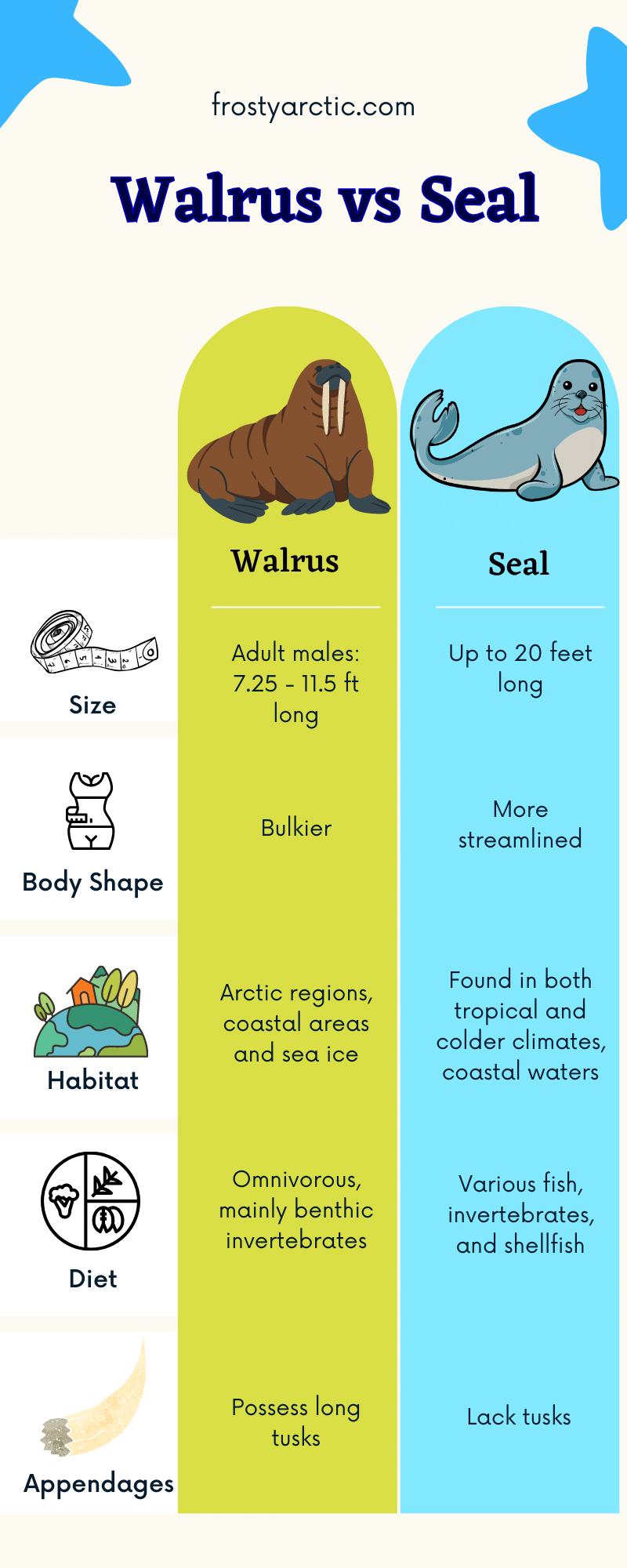
Isn’t the ocean captivating with its diverse array of species, each unique in its own way? When you think about sea creatures, you probably imagine the agile seals or the formidable walruses. These are two popular marine mammals, yet people often mix them up.
But the truth is, they are very different! We are here with a wealth of surprising information, so keep reading to uncover the fascinating secrets of these ocean dwellers!
Walrus vs Seal – A Quick Comparison
| Feature | Walrus | Seal |
| Family | Odobenidae | Phocidae |
| Body Shape | Bulkier | More streamlined |
| Tusks | Possess long tusks | Lack tusks |
| Size | Adult males: 7.25 – 11.5 ft long | Up to 20 feet long |
| Diet | Omnivorous, mainly benthic invertebrates | Various fish, invertebrates, and shellfish |
| Habitat | Arctic regions, coastal areas and sea ice | Found in both tropical and colder climates, coastal waters |
| Social Behavior | More social; lives in large herds | Often solitary or in smaller groups |
| Agility | Less agile, especially on land | More agile in water & land |
| Lifespan | 30-40 years | Up to 35 years |
| Gestation Period | 15-16 months | About 9-11 months |
| IUCN Status | Vulnerable | Varies by species (e.g., Least Concern to Endangered) |
Walrus vs Seal: What Are the Key Differences?
Walruses and seals, bound by their shared existence as marine mammals, are exceptional beings adapted to thrive in aquatic ecosystems. Both are remarkable swimmers equipped to navigate the vast ocean expanses.
However, despite these shared traits, walruses and seals harbor numerous differences as distinctive as the marine environments they inhabit. So, let’s dive in and uncover these fascinating differences!
1. Taxonomy and Scientific Classification
Seals and Walruses belong to different families within the order Carnivora.
Walrus
The walrus is a large marine mammal with flippers. It is the only living species in the family Odobenidae, part of the order Carnivora. It is scientifically known as Odobenus rosmarus.
Interestingly, there are two subspecies of walruses
- the Atlantic Walrus (Odobenus rosmarus rosmarus)
- the Pacific Walrus (Odobenus rosmarus divergens).
Seal
Seals are divided into two families:
- Phocidae (the earless or true seals)
- Otariidae (eared seals).
They all belong to the order Carnivora.
Phocids, the true seals, lack external ear flaps and have sleek, spindle-shaped bodies with well-developed, homogenous flippers. Notable examples include
- the harbor seal (Phoca vitulina)
- the grey seal (Halichoerus grypus).
Otariids, sea lions and fur seals have outer ear flaps, long fore flippers, the capability to walk on all four of them, and short, thick hair.
Examples include
- the California sea lion (Zalophus californianus)
- the northern fur seal (Callorhinus ursinus).
| Aspect | Walrus | Seal |
| Order | Carnivora | Carnivora |
| Family | Odobenidae | Phocidae (earless or true seals), Otariidae (eared seals) |
| Genus & Species | Odobenus rosmarus | Diverse, e.g., Phoca vitulina, Halichoerus grypus, Zalophus californianus |
2. Habitat and Distribution
Sea Lions and Seals prefer different habitats and are found in different geographical locations.
Walrus
Walruses are predominantly found in the frigid waters of the Arctic Circle. They are usually found in
- Europe
- Canada
- Greenland,
- Russian Federation
- Svalbard
- Jan Mayen
- Alaska.
Walruses are particularly known to inhabit areas where the sea ice is present but not too densely packed. This is because they use the ice as resting platforms when they’re not foraging for food on the seafloor. As the ice melts with the changing seasons, walruses migrate, following the ‘edge’ of the ice to remain in their favored habitat.
Seal
Seals, conversely, live in a wider range of species and thus have a much more diverse distribution. They can be found in various parts of the world, from the polar regions to the tropics.
- Harbor Seal and Grey Seal: North Atlantic and the North Pacific Oceans
- Harp Seal: Arctic and northernmost Atlantic
- Hooded Seal: Central and Western North Atlantic
- Leopard Seal and Weddell Seal: Antarctic
- Monk seal: the Mediterranean and the Hawaiian Islands
- Elephant seal: California and Baja California in Mexico.
They prefer a range of habitats, such as coastal areas and open ocean environments. They haul out onto land or ice to rest, molt, and breed.
| Aspect | Walrus | Seal |
| Habitat | Arctic Circle | Global distribution, both in cold Arctic and Antarctic regions and in tropical climates |
| Location | Europe, Canada, Greenland, Russian Federation, Svalbard, Jan Mayen, Alaska | North Atlantic, North Pacific, Mediterranean, Hawaiian Islands, California, Baja California, Mexico |
3. Physical Appearance
Both walruses and seals are marine mammals belonging to the pinniped family, which means they share some common physical features. However, they also have distinct characteristics that set them apart.
Walrus

- Size: Walruses are among the largest pinnipeds. Adults can reach up to 11 to 12 feet long and weigh between 680 to 1,700 kg.
- Tusks: One of the most striking features of a walrus is its long, ivory tusks. Both male and female walruses possess tusks. These tusks can grow up to 1 meter in length and are actually elongated upper canine teeth.
- Whiskers: Walruses have stiff whiskers, also called vibrissae, around their snouts.
- Body Color: Adult walruses typically have a pinkish or reddish-brown skin color, which is a result of capillaries in their skin and exposure to sunlight.
- Blubber Layer: Walruses have a thick layer of blubber beneath their skin, which helps insulate them from the cold Arctic waters and store energy for long journeys and periods of fasting.
Seal
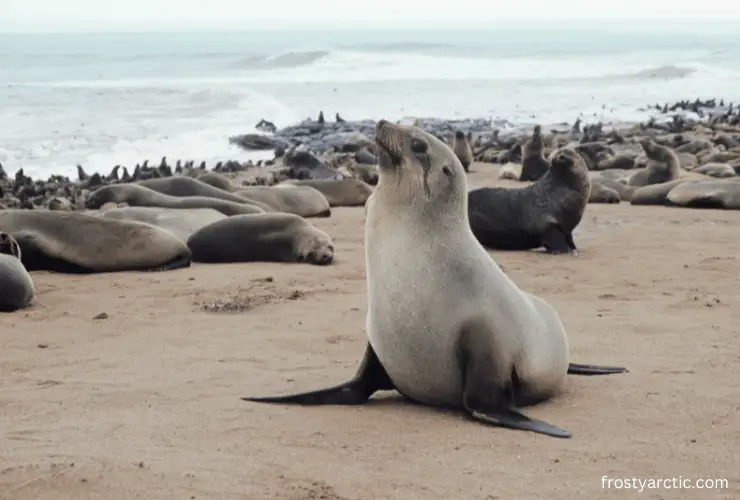
- Size: Seals come in various sizes depending on the species. Some smaller species, like the ringed seal, may reach lengths of around 4 to 5 feet. Larger species, such as the elephant seal, can grow much bigger, with adult males reaching lengths of up to 20 feet.
- No External Ear Flaps: Seals lack external ear flaps, giving their heads a more streamlined appearance than walruses.
- Tusks Absent: Unlike walruses, seals do not have prominent tusks. Instead, they have regular teeth adapted for catching and consuming their prey.
- Whiskers: Similar to walruses, seals also possess sensitive whiskers.
- Body Color: Seal species can have different body coloration, ranging from light to dark gray, brown, or even spotted patterns, depending on the species.
- Blubber Layer: Seals also have a blubber layer beneath their skin, providing insulation and energy reserves for their aquatic lifestyle.
| Physical Feature | Walrus | Seal |
| Size | up to 11-12 feet | Various sizes (4-20 feet) |
| Tusks | Prominent ivory tusks | No prominent tusks |
| Whiskers | Dense and used for food detection | Sensitive whiskers for food detection |
| External Ear Flaps | Present | Absent |
| Body Color | Pinkish or reddish-brown | Gray, brown, or spotted patterns |
| Blubber Layer | Thick for insulation and energy storage | Present for insulation and energy storage |
4. Diet and Feeding Habits
Both walruses and seals are carnivorous marine mammals but have different diets and feeding habits due to their distinct anatomies and habitats.
Walrus
Walruses are primarily benthic feeders, which means they search for food on the ocean floor. Their diet mainly consists of a variety of bottom-dwelling organisms, with the majority being benthic invertebrates. Their favorite prey items include
- Clams
- Mussels
- Snails
- Shrimp
- Crabs
- Worms.
Walruses utilize their sensitive whiskers to locate food in the soft sediment on the ocean floor. Once they detect potential prey, they employ their strong tusks to create holes in the substrate. Then, they use their powerful suction abilities to draw in water and sediment. They filter out the food from the water, consuming their catch.
Walruses are known for their efficient hunting strategies. They can make numerous dives, sometimes reaching depths of around 90 meters, in search of food. Their ability to stay submerged for extended periods allows them to explore the seafloor thoroughly, as detailed in an article published in Polar Biology.
Seal
Seals have a more varied diet than walruses, as different seal species inhabit various environments. Generally, seals are opportunistic predators, consuming a wide range of marine organisms. Their diet includes
- Fish
- Squid
- Crustaceans
- Various species of invertebrates.
Seals primarily hunt while swimming in open water. They are agile and swift swimmers, capable of reaching impressive speeds. When pursuing prey, seals use their keen eyesight and excellent underwater vision to spot and chase down their target.
Seals display impressive hunting tactics. They often approach their prey stealthily and then launch themselves to catch the prey by surprise. Depending on the species, seals may exhibit different techniques, such as chasing, ambushing, or cooperative hunting in groups.
| Aspect | Walrus | Seal |
| Diet | Primarily benthic invertebrates (clams, mussels, etc.) | A varied diet, including fish, squid, etc. |
| Feeding Techniques | Sensitive whiskers and suction for benthic feeding | Agile swimming and chasing techniques |
5. Social Behavior
Walruses and seals are both social animals, but their social behaviors differ due to variations in their species, habitat, and group structures.
Walrus
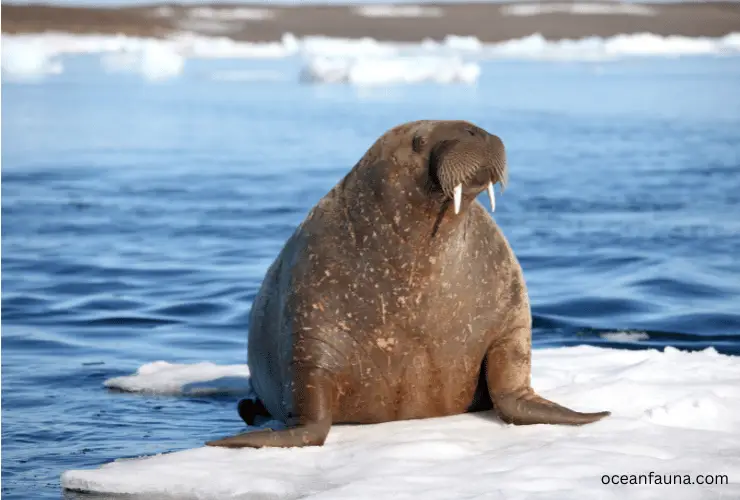
- Group Structure: Walruses are highly gregarious animals. They form large, tight-knit social groups, consisting of several individuals, ranging from a few to thousands.
- Hierarchy and Communication: Within the herd, walruses establish social hierarchy based on age, size, and dominance. They use vocalizations and physical displays to communicate within the group.
- Migratory Behavior: They are known for their seasonal migrations between feeding and breeding grounds. During these migrations, walruses may form massive aggregations on land or ice, creating impressive gatherings known as “haulouts.”
- Breeding Grounds: Dominant males establish territories to attract females for mating.
- Mother-Calf Bonds: Walrus mothers exhibit strong maternal instincts. They form close bonds with their calves and care for them, as detailed in the book Ethology and Behavioral Ecology of Otariids and the Odobenid.
Seal
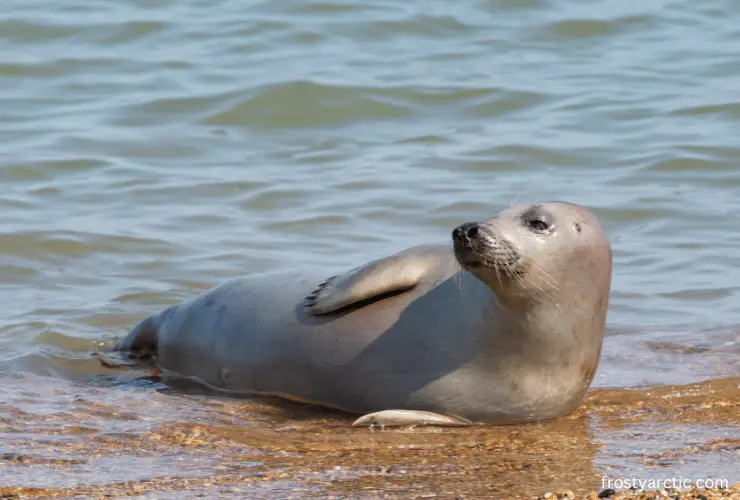
- Group Structure: Seals also have social tendencies, but their group structures vary significantly among species. Some seals are more solitary, while others form small groups or colonies.
- Breeding and Mating: Seals aggregate during the breeding season, but the size and stability of these groups differ. Some species form temporary mating groups, while others form more stable colonies.
- Communication: Seals use vocalizations and body postures for courtship, territory defense, and warning of dangers.
- Mother-Pup Bonds: Female seals are dedicated mothers, who form strong bonds with and nurse their pups with rich milk.
- Group Size: Some seal species come together in larger groups during resting periods on beaches or ice floes, known as “haulouts” or “rookeries”, as explained in the book Encyclopedia of Marine Mammals (Third Edition).
| Social Behavior | Walrus | Seal |
| Group Structure | Large herds with complex hierarchies | Varied, from solitary to small groups/colonies |
| Communication | Vocalizations, body postures, and displays | Vocalizations and body postures |
| Migratory Behavior | Seasonal migrations between feeding and breeding grounds | Varies among species |
| Breeding Grounds | Dominant males establish territories for breeding | Form temporary mating groups or colonies |
| Mother-Pup Bonds | Strong maternal bonds and care for calves | Strong maternal bonds and care for pups |
6. Reproduction and Lifecycle
Seals and Walruses have distinct reproductive behaviors and lifecycles.
Walrus
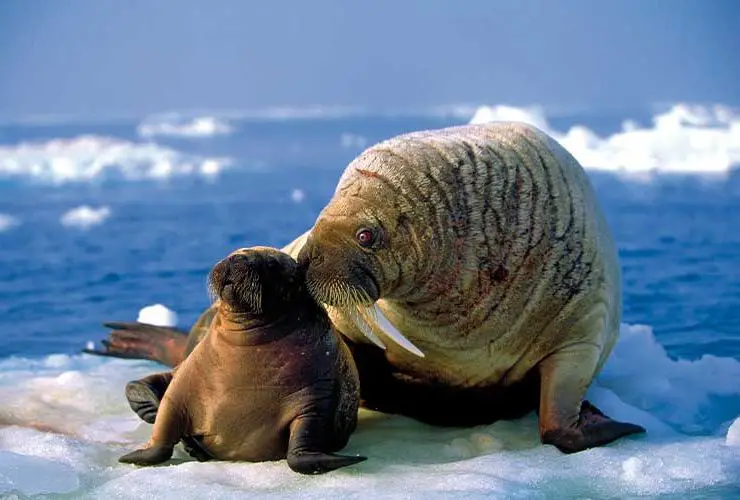
Walruses display sexual dimorphism and have a polygynous breeding system.
Mating typically occurs in the water during January and February. However, even though fertilization happens around this time, the fertilized egg doesn’t implant itself and begins to grow immediately. This is referred to as delayed implantation.
The delay can last until June, allowing the female walrus to time the birth of her calf to match more favorable environmental conditions.
The gestation period lasts about 15 months. The female will then give birth to a single calf, rarely twins, in the late spring or early summer.
The weaning process starts when the calves are about 2 years old. However, they may remain with their mothers for over five years.
Female walruses reach this sexual maturity around 7 to 10 years. Males typically breed usually around 15 years of age.
The average lifespan of Walruses is around 40 years in the wild. ~Source
Seal

Like walruses; seals mate in the water. However, the timing of mating varies greatly among seal species, with some breeding in summer and others in winter.
Females are also polyestrous, but unlike walruses, seals do not experience delayed implantation.
The gestation period for seals typically lasts around 9-11 months, depending on the species. Seal pups are usually born on land or ice, with a thick coat of fur known as lanugo.
Weaning in seals is a more abrupt process compared to walruses. Depending on the species, it can occur as early as a few days to a few months after birth.
Seals reach sexual maturity at around 3-6 years for females and 9-15 years of age for males, varying by species.
The average lifespan of a seal can be up to 25-30 years, though this can vary greatly by species. ~Source
| Characteristics | Walrus | Seal |
| Mating Period | Winter (January – February) | Varies greatly among species |
| Delayed Implantation | Yes | No |
| Gestation Period | ~15 months (including delay) | ~9-11 months |
| Birth Location | Water | Land/Ice |
| Weaning | Starts at 2 years, may last until 5 years | A few days to a few months after birth |
| Sexual Maturity | Females: ~6 years, Males: Breed around 15 years | Females: ~3-6 years, Males: 9-15 years |
| Lifespan | ~40 years in the wild | ~25-30 years in the wild |
7. Natural Predators
Both Seals and Walruses have several natural predators in their environment despite their size and strength.
Walrus
Primarily, polar bears and killer whales are known to prey on walruses, especially calves and sick or injured individuals.
Seal
Similar to walruses; seals are also preyed upon by orcas and polar bears. However, seals are also hunted by the great white shark, especially the ringed seals.
| Species | Natural Predators |
| Walrus | Killer whales (primary), polar bears |
| Seal | Killer whales, great white sharks, polar bears |
8. Walrus vs Seal: Defense Mechanism
Both Seals and Seals have unique defense mechanisms to protect themselves from predators.
Walrus
The primary defense mechanism of the Walrus is its large, powerful tusks. When threatened, a walrus will brandish and jab with its tusks.
Another significant defense mechanism of the walrus is its thick skin and layer of blubber, which provide physical protection against potential threats.
When threatened, walruses often retreat into the water, where they can use their swimming skills to evade predators, as described in the book Encyclopedia of Marine Mammals.
Seal
Seals are less bulky and don’t have the long tusks of walruses, but they have evolved their own defense mechanisms to survive.
They are more streamlined and agile in the water than walruses. This agility, combined with their speed, often allows them to outmaneuver predators. Some seal species can reach speeds up to 20 miles per hour in water.
Seals can use their sharp teeth and claws to defend themselves when cornered or threatened. They can deliver a nasty bite or scratch to would-be predators, causing enough harm to deter the attack. Their skin color often blends with their environment, allowing them to hide from predators, as detailed by the Royal Society Open Science.
| Defense Mechanism | Walrus | Seal |
| Primary Defense | Tusks and size | Agility and speed |
| Secondary Defense | Thick skin and blubber | Teeth and claws |
9. Interaction With Humans
Human interaction with both Walruses and Seals also varies.
Walrus
Walruses have a long history of interaction with humans, particularly with indigenous peoples of the Arctic region.
Indigenous communities like the Inuit have hunted walruses for thousands of years as a part of their subsistence lifestyle. They are hunted for their tusks, meat, and skin.
Some indigenous communities also view walruses as important cultural and spiritual symbols.
Seal
Seals have also interacted with humans for millennia. They have been hunted by coastal communities worldwide for their meat, oil, and fur. Some indigenous cultures also revere seals as spiritual beings.
Seals, especially those species that live close to human settlements, have been known to interact with people quite directly.
However, seals are often blamed for depleting fish stocks. They can become entangled in fishing gear, leading to injury or death. Some seals are also hunted or culled believing it will protect fish populations.
| Characteristics | Walrus | Seal |
| Usage | Hunted for meat, blubber, tusks, and hides | Hunted for meat, oil, and fur |
| Cultural Significance | Viewed as cultural and spiritual symbols by some indigenous communities | Revered as spiritual beings in some indigenous cultures; presence in folklore and mythology |
10. Threats and Conservation Status
Both Walruses and Seals face various threats from natural and human-induced environmental changes. The specific threats to each species and their conservation status vary considerably.
Walrus
One significant threat to walruses is climate change, specifically the loss of sea ice in the Arctic region. ~Source
Other threats include:
- Overhunting
- Oil and gas development in the Arctic.
In terms of conservation status, the walrus is listed as “Vulnerable” on the IUCN Red List.
Seal
The threats to seals are varied and largely depend on the specific species. However, there are some common threats that many seals face.
Climate change is a significant threat to seals, particularly for species like the ringed seal and harp seal, which rely on sea ice for breeding and molting. ~Source
Other threats include
- Marine pollution, including oil spills and plastic waste
- Overfishing.
As per the IUCN, the conservation status of Seals varies greatly by species. For example, the
- Mediterranean Monk Seal is “Endangered,”
- Harbor Seal, Grey Seal, Harp Seal, Leopard Seal, and Weddell Seals are of “Least Concern”.
| Characteristics | Walrus | Seal |
| Threats | Climate change (loss of sea ice), overhunting, oil and gas development | Climate change, overfishing, marine pollution, bycatch |
| Conservation Status | Vulnerable | Varies by species (ranging from “Least Concern” to “Endangered”) |
11. Walrus vs Seal: Who Would Win the Battle?
Walruses are considerably larger than most seals but smaller than Elephant Seal. If there’s a fight between a walrus and an elephant seal, the walrus could try to use its tusks to attack the elephant seal.
But the Elephant seals are more aggressive, with their battles often resulting in bloody injuries. With their immense strength, they can deliver powerful blows that the walrus would find challenging to counter.
The elephant seal can also reach above the walrus and hit the back of the walrus’s head and neck. This area is very delicate and could get hurt easily.
However, the walrus’s long, sharp tusks can potentially deliver a significant wound if the walrus manages to land a well-placed hit.
Although this situation is less likely due to the elephant seal’s superior size and strength, the chance isn’t zero. Thus, there’s a possibility, about one out of ten times, that the walrus could indeed get lucky and wound the elephant seal.
Therefore, in a matchup between a walrus and an elephant seal, the seal would probably come out on topmost of the time, with the walrus standing a slim chance.
Wrapping Up
So, are walrus and seal the same? Far from it! Although both are marine mammals and share some similar traits, like their aquatic lifestyles, the differences between them are profound.
From physical characteristics, such as the walrus’s distinctive tusks and the seal’s sleek body, to behavioral differences, including the walrus’s social herding and the seal’s often solitary nature, these species are uniquely adapted to their respective roles in the ocean’s ecosystem.
We hope our blog post has satisfied your thirst for knowledge and given you a greater appreciation for the rich life in our oceans. Don’t hesitate to come back for more fun comparisons!


